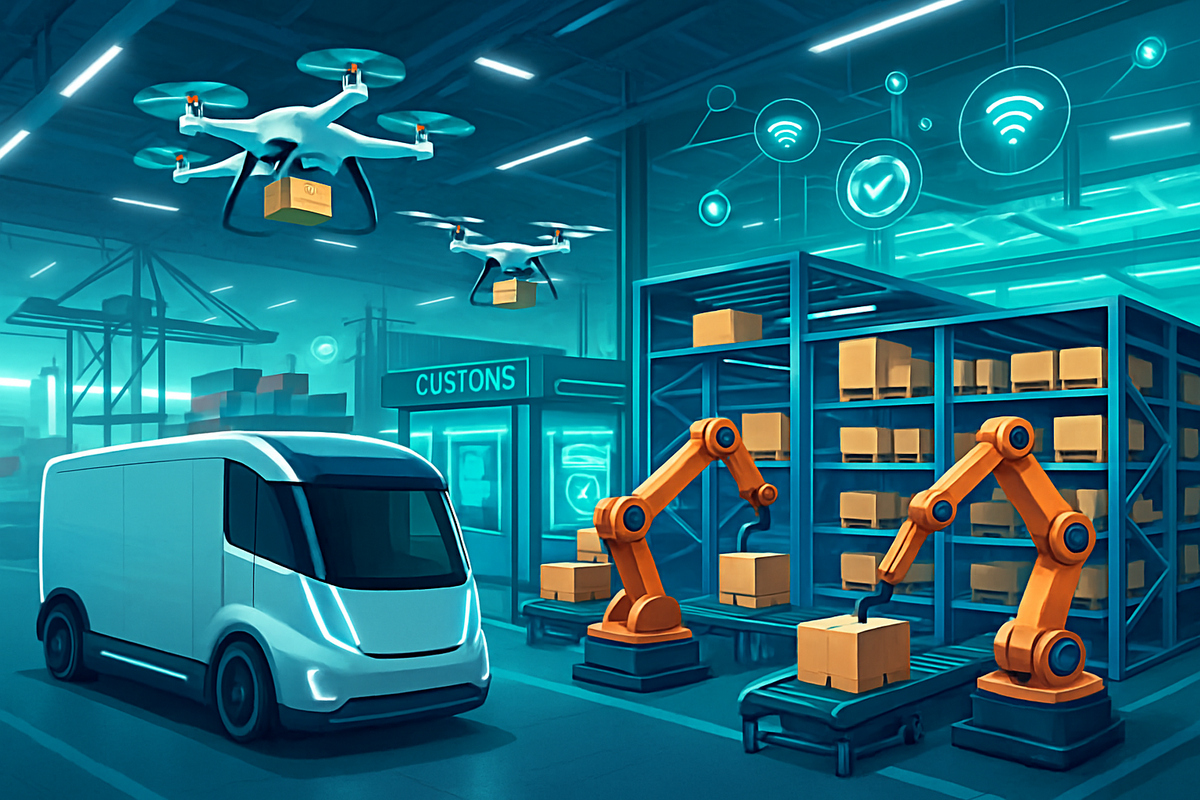How Agentic AI and Physical AI Agents Will Transform Global Logistics (2025–2030): The Next Frontier in Autonomous Supply Chains
Explore how agentic AI and autonomous robots are revolutionizing logistics, transforming supply chains into resilient, self-healing networks poised to slash costs, boost efficiency, and redefine global trade dynamics. Are you ready for the intelligent logistics era?

Welcome to the Age of Autonomous Logistics
Imagine this: It’s a Tuesday morning in 2028. You order a gadget from halfway across the world. Instantly, a web of AI-powered robots, self-driving trucks, and hyper-intelligent software agents springs into action—no coffee breaks, no traffic jams, no "out to lunch" signs. In less time than it takes to binge-watch a sitcom, your package arrives at your door, having zipped through ports, customs, and warehouses with barely a human fingerprint on it.
"By 2028, at least 15% of daily work decisions in logistics will be made autonomously by agentic AI systems."
—Gartner 2025 Strategic Tech Trends
Welcome to the next frontier: Agentic AI and Physical AI Agents are redefining the global supply chain.
What Are Agentic AI and Physical AI Agents?
Agentic AI refers to autonomous software systems that don’t just analyze data—they make decisions, plan, and act independently. Think of them as digital logistics masterminds, orchestrating goods and data flows 24/7.
Physical AI Agents are their real-world counterparts: robots, drones, and smart vehicles equipped with advanced AI, capable of sensing, reasoning, and physically interacting with their environment. These agents combine perception, cognition, and actuation to execute tasks without human micromanagement.
- Perception: Sensors and cameras gather real-time data (location, temperature, obstacles, etc.).
- Cognition: AI models process information, make decisions, and optimize routes or workflows.
- Actuation: Robots, drones, or autonomous vehicles physically move goods, sort parcels, or load containers.
Why Logistics? Why Now?
The logistics industry is the bloodstream of the global economy—yet, it’s long been a patchwork of manual labor, paper trails, and late-night phone calls. Enter agentic AI and physical agents, ready to slash inefficiencies, reduce costs, and future-proof supply chains against everything from pandemics to Suez Canal blockages.
Here’s why this revolution is accelerating between 2025 and 2030:
- Explosion of IoT Devices: Billions of sensors now track goods globally in real time.
- Advances in Robotics: Smarter, more dexterous robots are leaving the lab and entering warehouses, ports, and even the open road.
- Cloud and Edge Computing: Lightning-fast processing enables instant decisions at the network’s edge—where the action is.
- AI Integration: AI models no longer just predict—they plan, negotiate, and execute.
Real-World Transformations (2025–2030)
Automated Warehouses: The Rise of the Robot Orchestra
Picture a warehouse where robots glide through aisles, picking, packing, and sorting, all synchronized by invisible AI conductors. These systems adapt in real time to demand spikes, weather disruptions, or supply shortages—no overtime required.
Self-Driving Freight: The Convoy Never Sleeps
Autonomous trucks and delivery bots are already piloting highways and city streets. Between 2025 and 2030, expect these fleets to multiply, reducing transit times and fuel costs while boosting reliability. Your late-night snack run may soon be delivered by a robot with better time management than most humans.
AI-Powered Ports & Smart Customs
Ports—historically bottlenecks of paperwork and waiting—are being transformed by AI agents that handle scheduling, cargo inspections, and customs processing. The result? Containers flow through like clockwork, and global trade gets a much-needed caffeine boost.
Key Benefits: Why Businesses Should Care
- Cost Savings: Automation can slash operational costs by 30–40% in logistics hubs.
- Resilience: AI agents reroute shipments instantly in response to disruptions—be it a snowstorm or a cyberattack.
- Speed: End-to-end automation means faster deliveries and happier customers.
- Transparency: Real-time tracking and AI-powered analytics offer radical supply chain visibility.
- Sustainability: AI can optimize routes and loads, reducing emissions and waste.
Challenges and Watch-Outs
Let’s not sugarcoat it—autonomous logistics isn’t a walk in the (robotic) park. Key hurdles include:
- Interoperability: Getting diverse AI systems and robots to play nicely together.
- Security: Protecting against cyberattacks that could hijack autonomous fleets.
- Ethics & Jobs: Balancing automation with the future of human workers.
- Regulation: Navigating a fast-changing global legal landscape for AI and robotics.
But as with any frontier, the biggest risks often come with the biggest rewards.
Action Steps: How to Prepare for the Autonomous Supply Chain
- Audit Your Tech Stack: Identify manual choke points that could be automated.
- Experiment with AI and Robotics: Start small—pilot a smart warehouse solution or test an autonomous delivery route.
- Invest in Data Infrastructure: Robust IoT and cloud platforms are the backbone of agentic AI.
- Upskill Your Team: Prepare your workforce for the shift by training in AI, robotics, and data literacy.
- Stay Informed: The landscape is changing fast—subscribing to expert-driven news (like ours!) is a smart move.
The Road Ahead: Are You Ready?
The logistics industry is no longer just about moving boxes—it’s about moving at the speed of intelligence. Agentic AI and physical agents are transforming supply chains from fragile webs into resilient, self-healing networks. The winners of the next decade will be those who embrace this shift early and boldly.
"The future belongs to those who prepare for it today. In logistics, that means betting on AI, automation, and the relentless pursuit of efficiency."
Ready to stay ahead of the next wave? Subscribe to Funaix Insider for the smartest insights on AI, automation, and the business of tomorrow. Only subscribers can join the conversation—and for now, it’s completely free.
Want to comment? Want more? Only subscribers can write and read comments. Subscribe for free today and join the future of logistics, one smart move at a time.




